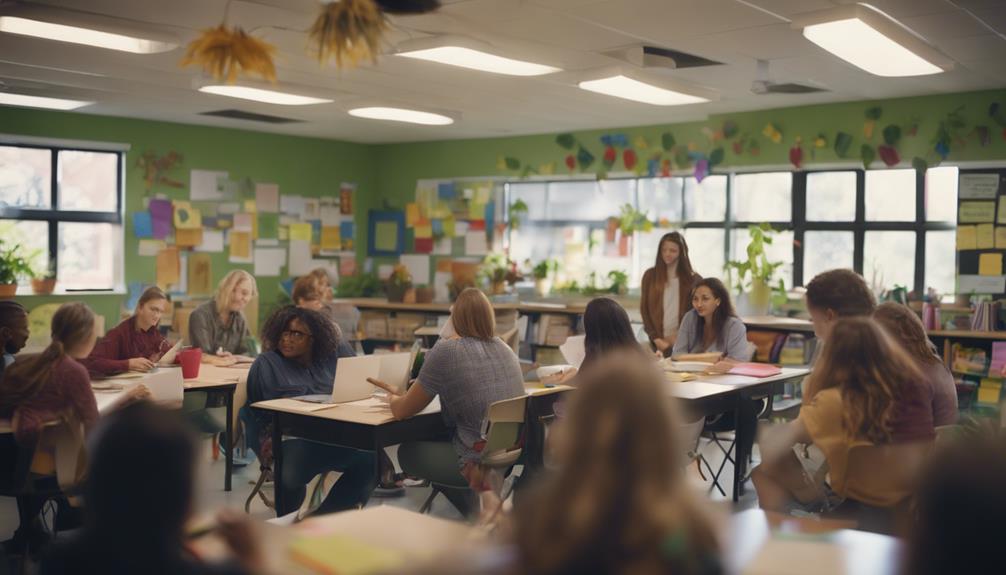Unlocking your teaching skills through constructive feedback is vital for growth and student success. It helps you identify your strengths and areas needing improvement. Focus on specific, actionable suggestions to make real changes. Timeliness is key; delivering feedback soon after classroom events makes it more relevant. Creating a supportive environment fosters a culture of openness, encouraging regular check-ins and peer observations. This approach not only boosts your confidence but also improves student engagement and outcomes. Dive deeper into effective strategies and insights to maximize the impact of your feedback process and enhance your teaching journey.
Key Takeaways
- Constructive feedback identifies specific strengths and areas for improvement, guiding teachers in refining their skills and enhancing student outcomes.
- Timely and actionable feedback fosters a culture of continuous improvement, ensuring teachers can implement changes effectively.
- A supportive feedback environment encourages a growth mindset, allowing teachers to embrace challenges and learn from their experiences.
- Regular peer observations and check-ins promote collaborative learning, facilitating the exchange of valuable insights among educators.
Significance of Constructive Feedback
Constructive feedback is crucial for your professional growth as a teacher, directly influencing both your skills and your students' success. It fosters a culture of continuous improvement, allowing you to refine your teaching practices. Receiving feedback also helps you understand where you may need to focus your efforts and improve, and it ultimately contributes to your effectiveness in the classroom. This feedback is especially valuable when it comes to distinguishing between teaching as a hard work vs hobby, and can provide insight into how to elevate your teaching from a personal interest to a professional pursuit. It’s important to embrace feedback as an opportunity for growth and development in your teaching career.
When you receive specific insights into your strengths and areas needing development, you can adapt and enhance your methods effectively. This feedback doesn't just boost your confidence; it also leads to better student outcomes.
Key Elements of Effective Feedback
Effective feedback must be specific, actionable, timely, clear, and supportive to truly enhance your teaching practices.
Specificity means pinpointing exact actions or behaviors, allowing you to understand what to improve.
Actionable feedback focuses on realistic changes you can implement, making it easier to adjust your methods.
Timeliness is crucial; the sooner you receive feedback after an event, the more relevant it is.
Clarity ensures you comprehend the message without confusion.
Finally, supportive feedback fosters a growth mindset, encouraging you to embrace challenges.
When these elements come together, you'll feel empowered to refine your skills, leading to better outcomes for your students and a more enriching teaching experience.
Embrace these key elements to unlock your potential!
Strategies for Delivering Feedback

To deliver impactful feedback, focus on being specific, actionable, and timely to truly benefit your teaching practice.
Start by pinpointing particular actions or behaviors you want to address, ensuring your feedback is clear and understandable. Rather than vague comments, offer concrete suggestions that can be realistically implemented. For instance, if a teaching method isn't working, suggest alternative strategies that can be easily integrated.
Timing is crucial; provide feedback shortly after the observed behavior to maximize its relevance.
Additionally, create a supportive environment where your colleagues feel comfortable receiving feedback. Regular check-ins and peer observations can reinforce continuous learning, helping everyone grow in their teaching practice and enhancing overall classroom performance.
Enhancing Feedback Value
While enhancing the value of feedback, it's essential to ensure it's delivered in a way that resonates with both teachers and students, fostering a deeper understanding and engagement in the learning process.
Focus on making your feedback specific and actionable, addressing particular behaviors and offering realistic steps for improvement.
Clarity is key; communicate your points in an easily understandable manner. Support your feedback with an encouraging tone to promote a growth mindset.
Incorporating visible learning principles can also help boost student engagement, making feedback more relevant and impactful.
Encourage students to actively participate in the feedback process, as this involvement deepens their understanding and ownership of their learning journey.
This collaborative approach builds trust and maximizes the feedback's value.
Timeliness in Feedback Delivery

Providing timely feedback is crucial, as it helps address issues before they escalate and supports a positive learning environment.
When you deliver feedback soon after an observation or lesson, you ensure it's fresh in your mind and relevant to the situation. This immediacy allows you to pinpoint specific actions and behaviors, making your suggestions more impactful.
By being prompt, you foster a culture of openness and continuous improvement, encouraging colleagues to engage with your insights. Additionally, timely feedback reinforces learning, showing that you value each teacher's growth.
Continuous Professional Development
Continuous professional development is essential for teachers to enhance their skills and adapt to the ever-changing educational landscape. Engaging in workshops, seminars, and online courses allows you to refine your expertise and stay current with teaching methods.
Collaborating with peers through reflective practices fosters a supportive learning environment and encourages growth. By seeking feedback from mentors, you gain valuable insights into your teaching practices, guiding your development effectively.
Establishing a culture of continuous learning not only benefits you but also positively impacts your students. Remember, adapting to new trends and best practices is key to maintaining your effectiveness as an educator.
Embrace these opportunities, and you'll unlock your full potential in the classroom.
Creating a Feedback Culture

Establishing a feedback culture in your classroom transforms not only your teaching practices but also enhances student engagement and learning outcomes.
By fostering an environment where feedback flows freely, you encourage both students and teachers to embrace growth. This means giving specific, actionable, and timely feedback that empowers everyone involved.
When you create opportunities for peer observations and coaching, you promote an atmosphere of support and collaboration. Make it a point to discuss challenges openly, ensuring that feedback feels constructive rather than critical.
Encourage students to participate in the feedback process, enhancing their understanding and ownership of their learning.
Ultimately, nurturing a feedback culture leads to continuous improvement for both you and your students, driving lasting educational success.
Frequently Asked Questions
How Can Feedback Be Integrated Into Daily Teaching Practices?
You can integrate feedback into daily teaching by providing timely, specific insights after lessons, encouraging student reflections, and fostering a supportive environment. Regular check-ins and peer observations also help enhance your teaching practices effectively.
What Role Do Students Play in the Feedback Process?
Students play a crucial role in the feedback process by actively participating, sharing their perspectives, and reflecting on their learning. Their insights help you tailor your teaching and enhance engagement, ultimately improving their educational experience.
How Can Technology Aid in Delivering Feedback Effectively?
Technology can streamline your feedback process by providing instant communication through apps and platforms. It allows you to share resources, track progress, and foster collaboration, making feedback more accessible, timely, and effective for everyone involved.
What Are Common Barriers to Receiving Feedback?
You might face common barriers to receiving feedback, like fear of criticism, lack of trust in the feedback source, or feeling overwhelmed by suggestions. These obstacles can hinder your growth and development as an educator.
How Can Feedback Improve Student-Teacher Relationships?
Feedback strengthens student-teacher relationships by fostering open communication, building trust, and encouraging collaboration. When you provide constructive insights, students feel valued and understood, creating a positive learning environment that enhances engagement and academic success.
Conclusion
Incorporating constructive feedback into your teaching practice is essential for your growth and your students' success. Taking feedback from colleagues and supervisors allows you to identify areas for improvement and refine your instructional techniques. By embracing constructive feedback, you demonstrate a commitment to continual professional development and a dedication to providing the best possible education for your students. Remember, teaching is more than just a hobby or hard work; it’s a constant learning process that requires adaptation and refinement.
By focusing on specific, timely, and supportive insights, you can foster an environment that encourages continuous improvement.
Embrace the feedback culture, engage with your peers, and commit to ongoing professional development.
Remember, every piece of feedback is an opportunity to refine your skills and create a thriving classroom.
Unlock your potential and watch both you and your students flourish!









